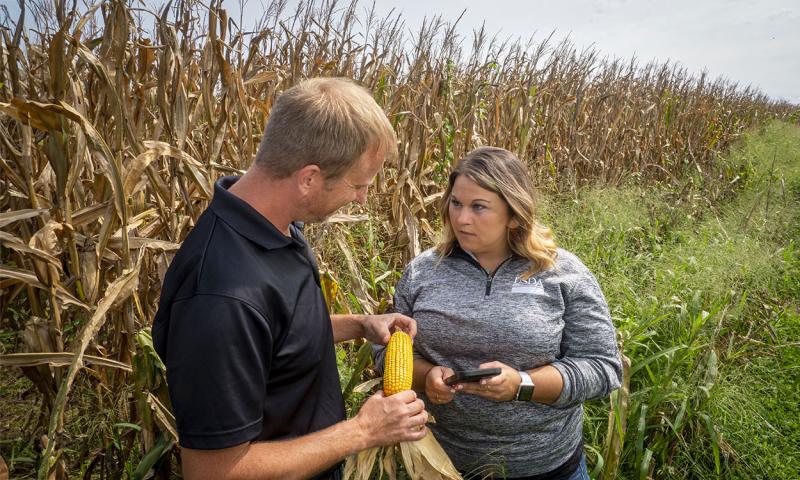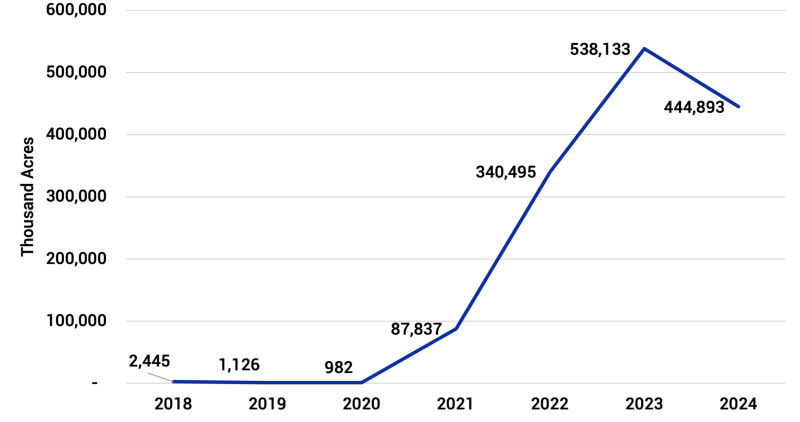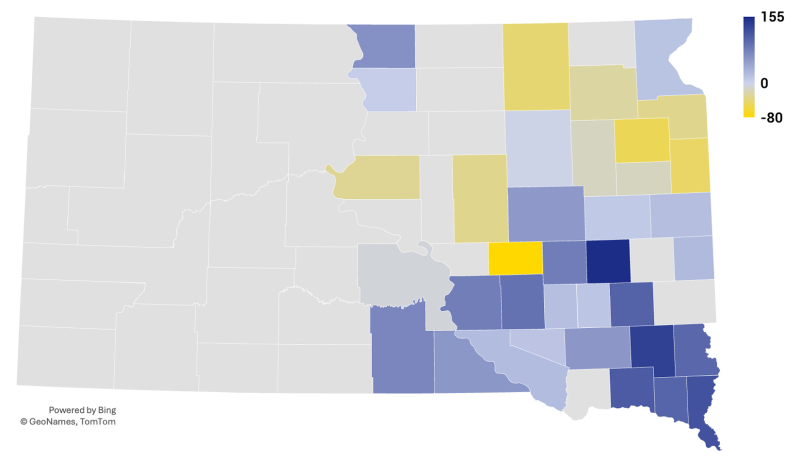Introduction

Farmers may be interested in exploring different aspects of crop insurance during the current agricultural conditions of low commodity prices and high input prices. One alternative available is Margin Protection (abbreviated as MP) crop insurance. Margin Protection can be purchased as a stand-alone policy or as an endorsement on a Yield Protection or Revenue Protection policy (RMA, 2023) The closing date for fall enrollment in MP insurance is September 30, 2024 for crops to be planted in 2025, such as corn, soybeans, and spring wheat in South Dakota.
What is Margin Protection?
MP is a newer product that allows farmers to insure prices, yields, and input costs. MP was offered for the first time in 2016 in Iowa and has expanded throughout the Midwest since then. MP differs compared to yield-based options, which insure against yield reductions; and revenue-based options, which insure against revenue reductions (price × yield). MP allows farmers to insure their margin, which is (price × yield) - cost (Watts and Associates, 2023). MP allows farmers to insure up to 95% of the margin, different from other products and the highest subsidized level of coverage available. MP is area-based and uses county-level estimates of costs and revenue. MP is offered on corn in all counties in South Dakota, and it is offered for soybeans and wheat in select counties.
How Margin Protection Works
Expected Margin
MP is based on the Expected Margin for the crop, which is calculated as follows:
- Expected Margin = Expected Revenue - Expected Costs
Where Expected Revenue and Expected Costs can be calculated as:
- Expected Revenue = Expected County Yield × Projected Commodity Price
- Expected Costs = Quantity of Each Allowed Input × Projected Input Price
Trigger Margin
The Trigger Margin can be calculated as follows:
- Trigger Margin = Expected Margin - Deductible
Where the Deductible can be calculated as:
- Deductible = (1.00 - Coverage Level) × Expected Revenue
Harvest Margin
The Harvest Margin is calculated as follows:
- Harvest Margin = (Harvest Yield × Harvest Price) - Harvest Costs
If the Harvest Margin is less than the Trigger Margin, then a loss may be paid for the policy (RMA, 2023; Watts and Associates, 2023).
Harvest Price Option
A farmer can also purchase MP with the Harvest Price Option (abbreviated as MP-HPO), where the Expected Revenue used to set the Trigger Margin is reset based on the harvest price (RMA, 2023). In South Dakota, purchasing an MP-HPO endorsement policy is more common than a standalone MP or MP-HPO policy.

Figure 1 shows the number of corn acres insured with an MP-HPO endorsement in South Dakota from 2018 to 2024. In 2023, there were 538,133 MP-HPO endorsed corn acres, representing 9% of the 6.3 million corn acres planted in South Dakota (RMA, 2023; NASS, 2023).
Indemnity Payment
The farmer using MP must also choose a protection factor for their policy, which ranges from 80% to 120% in 1% increments. MP establishes a maximum indemnity payment to account for policies with a base policy.
The indemnity payment calculation uses the elected protection factor, and is calculated as follows:
- Dollar Amount of Insurance = (Expected Area Yield × Projected Price) × Coverage Level × Protection Factor for MP
- Dollar Amount of Insurance = Expected Area Yield × Max (Margin Projected Price or Margin Harvest Price) × Coverage Level × Protection Factor for MP-HPO (RMA, 2024).
Farmers are not allowed to purchase additional coverage or endorsements that duplicate the coverage range of MP if they purchase MP, such as the Supplemental Coverage Option (abbreviated as SCO) or Enhanced Coverage Option (abbreviated as ECO) (RMA, 2024).
MP Input Cost and Commodity Price Calculations
Two types of inputs are considered for calculating costs: inputs subject to price change and inputs fixed from planting to harvest (for example, seed and machinery). The inputs subject to price change for corn are diesel, urea, diammonium phosphate (DAP), potash, and interest (RMA, 2023). The cost calculations take the simple average reported price for the projected input price discovery period from the commodity exchanges in Table 1.
| Input | Commodity Exchange | Contract Commodity | Contract Month | Projected Input Price Discovery Period | Harvest Input Price Discovery Period |
|---|---|---|---|---|---|
| Diesel | NYMEX | ULSD | May | Aug 15–Sept 14 | Apr 1–Apr 30 |
| DAP | CME | DAP FOB NOLA | May | Aug 15–Sept 14 | Apr 1–Apr 30 |
| Urea | CME | Urea FOB US Gulf | May | Aug 15–Sept 14 | Apr 1–Apr 30 |
| Potash | USDA AMS | FOB Distributor Central IL | Cash Price | Aug 15–Sept 14 | - |
| Interest | CME | 30-Day Federal Funds | Contract month immediately following harvest price period for state and county | Aug 15–Sept 14 | Contract month immediately following harvest price period for state and county |
Source: RMA, 2024
The calculation for the margin projected price and margin harvest price uses the average daily settlement price for the projected price discover period for the harvest year’s futures contract. This is the December CBOT corn contract from August 15 to September 14 for the MP projected price discovery period and the December CBOT corn contract from October 1 to October 31 for the MP-HPO harvest price discovery period (RMA, 2024).
MP Insurance Performance in South Dakota
The average payment to South Dakota farmers on corn acres from the MP-HPO insurance policy is explored further. MP was widely offered across the Midwest starting in 2018, but in the first three years, very few acres were covered in South Dakota, so we use 2021, 2022, and 2023 in our analysis. The allowable counties have expanded over time in South Dakota, which is part of the gradual increase in policies sold. The average payout per acre for MP for the farmer [(Indemnity - Farmer Paid Premium) ÷ Acres Enrolled] in dollars per acre is shown in Table 2. On average, over the last three years, MP crop insurance paid $28 per acre across all corn acres and counties in South Dakota.
|
|
|
|---|---|
|
|
|
|
|
|
|
|
|
Source: RMA Summary of Business
County-Level Data

Figure 2 shows the average payment from 2021 to 2023 on corn acres at the county level. The highest average net payouts on corn acres over the last three years from the policy occurred in the state's Southeast corner. On average, the highest net payments occurred in Turner County, with an average payment of $153 per acre over the last three years. The lowest payment occurred in Jerauld County, with an average payment (loss) of -$81 per acre over the last three years.
Conclusion
MP is an alternative South Dakota farmers have for insuring their corn, soybean, or wheat acres against margin losses. Farmers may need to explore all alternatives when making crop insurance decisions in the current agricultural conditions of high input and low commodity prices. There has been growth in the use of the MP-HPO endorsement on South Dakota corn. Further analysis of the cost components of MP crop insurance and how they affect the payouts over time will be performed to help farmers better understand the performance of MP.
References
- National Agricultural Statistics Service (NASS). 2024. 2023 State Agricultural Overview: South Dakota.
- RMA. 2023. Margin Protection for Federal Crop Insurance.
- RMA. 2024. Margin Protection Insurance Standards Handbook.
- RMA. Summary of Business Report Generator.
- Watts and Associates. 2023. Margin Protection 2024 Crop Year.

